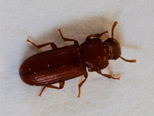
Problems with pantry pest and in particular Flour Beetles are entirely controllable under professional care. Our treatment goal is to stop a problem at its source so it doesn’t keep coming back. Using state-of-the art equipment and methods, our licensed exterminators will inspect your home’s environment and construction to identify the problem and determine the best course of action. Contact us today!
The most common Flour Beetle in the northern states is the Confused Flour Beetle
Adults are very active, quickly running for cover when disturbed, and can be found either on the surface or deep within the food material. These beetles breed in damaged grain, grain dust, high-moisture wheat kernels, flour, etc. They have been found in barley, breakfast cereals, corn, cornmeal, crackers, flour, millet, oats, rice, rye, wheat and wheat bran, nutmeats, dried fruits, legume seeds, beans, milk chocolate, cottonseed, peas, powdered milk, sunflower seeds, vetch seeds, spices, herbarium and museum specimens.
This beetle is about 1/8 to 1/4 inch in length, with a reddish-brown color, and its small size allows it to work its way inside many sealed containers. It will primarily eat milled grain products, such as flour and cereals. Both adults and larvae feed on grain dust and broken kernels, but not the undamaged whole grain kernels. In addition to flour, they will eat rice, dried fruit, nuts, and beans. This beetle will also hide in crevices, and corners of pantries.
They typically spoil foods with fecal pellets, dead bodies, and secretions. Flour Beetles often hitchhike into the home in infested flour and can multiply into large populations. Some survive on food accumulations in cabinet cracks, crevices, and furniture. Confused flour beetles are the most abundant and injurious insect pest of flour mills in the United States.
Badly infested flour is characterized by a sharp odor and moldy flavor. They do not bite or sting humans or pets, or feed on or damage the house or furniture. However beetles may be attracted to and eat rat fecal pellets and may contract and can carry tapeworms.
If you detect these beetles early, disposal alone may solve the problem. Dispose of heavily infested foods in wrapped, heavy plastic bags or in sealed containers and leave for garbage disposal service.
Careful sanitation is the best method to avoid stored-product pests. After removing all food, food packages, utensils, dishes, etc. from the cupboard, shelves, or storage area, use a strong suction vacuum cleaner with proper attachments to clean all spilled foods (cornmeal, toaster crumbs, bits of pet food, raisins, etc.) from the cracks and crevices, behind, under, and in appliances and furniture.
Scrub with soap and hot water. After shelves are thoroughly dry, cover with clean, fresh paper or foil before replacing with food or cooking utensils